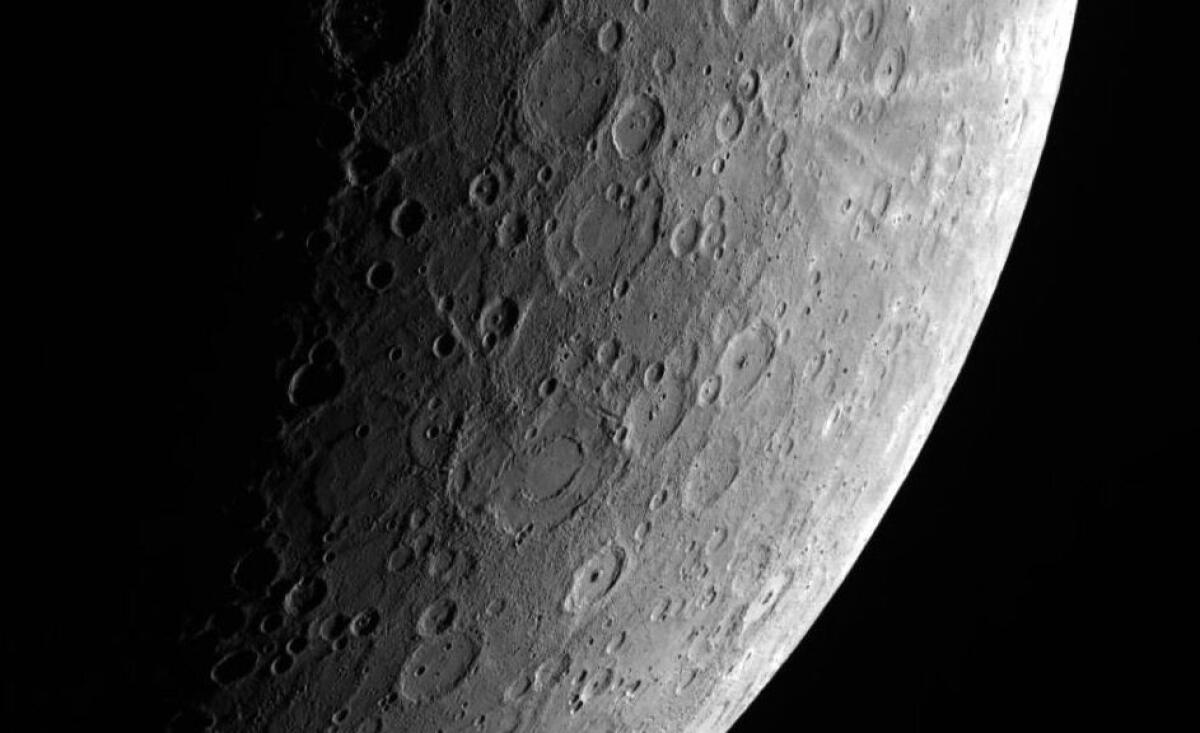How a steady stream of comet dust may have ‘painted’ Mercury black

- Share via
The mystery of Mercury’s excessively dark surface may have just been solved.
A team of researchers working at Brown University say the planet’s inky appearance may be the result of a near constant rain of impacts from tiny specks of cometary dust that “painted” the planet black over billions of years.
The research was published Monday in Nature Geoscience.
Scientists have long wondered why Mercury was so much darker than our moon -- reflecting just one-third of the amount of light that the moon reflects.
The two bodies are often compared, explained lead author Megan Bruck Syal, who is a postdoctoral researcher at the Lawrence Livermore National Laboratory in Livermore, Calif. They are roughly the same size, and because neither one has much of an atmosphere, they are both subject to a constant bombardment from bits of space dust and other micrometeorites.
(Here on Earth, micrometeorites burn up in the atmosphere, causing shooting stars).
Many airless bodies get their dark color from iron-bearing minerals on their surface, but that is not the case with Mercury. Observations by NASA’s Messenger spacecraft have shown that the surface of Mercury is less than 2% iron. Scientists intent on solving this mystery had to look for another darkening agent.
“One thing that hadn’t been fully considered before was carbon,” Bruck Syal said. “Carbon is really abundant in comets and could be delivered by cometary dust.”
Paradoxically, full-size comets could not be responsible for depositing enough carbon on Mercury’s surface to darken it. That’s because a large comet would strike the planet with so much speed that all the impact material would go shooting off into space. But impacts from cometary dust were a different story.
“The little dust particles less than a millimeter in size are also very carbon rich, and they come in at lower speeds,” Bruck Syal said. “We did a lot of calculations about different impact angles and velocities and found you could retain most of the material on the planet.”
After determining that carbon from cometary dust could remain on Mercury’s surface, the team had to make sure that Mercury would be hit with enough dust to account for the planet’s dark appearance.
Here again, the pieces fit together. The density of cometary dust increases as you get closer to the sun, and after further calculations, the researchers determined that Mercury is likely struck by 50 times as many bits of cometary dust as the moon.
“It’s pretty constant,” Bruck Syal said. “Unlike asteroid or comet impacts that are kind of hard to predict, this is more of a steady state.”
The final step was to make sure that the impact of carbon dust on the surface of Mercury would indeed have a darkening effect. To test that, the researchers turned to the NASA Ames Vertical Gun Range in Mountain View, Calif. There a 14-foot cannon fueled by hydrogen gas allows researchers to shoot projectiles into targets at speeds of more than 3.5 miles per second, imitating celestial impacts.
By creating target materials similar to what they expect to find on the surface of Mercury, the scientists were able to demonstrate that cometary dust impacts would indeed produce dark materials that would be deposited on the planet’s soil.
The hypothesis addresses a lot of questions about what is making Mercury so dark, but Bruck Syal said it still needs to be tested.
“I know the Messenger mission is doing a low-altitude campaign right now trying to get more carbon abundance data,” she said. “If we could have some outside verification of how much carbon there is ... that would be the ultimate test.”
Science rules! Follow me @DeborahNetburn and “like” Los Angeles Times Science & Health on Facebook.






